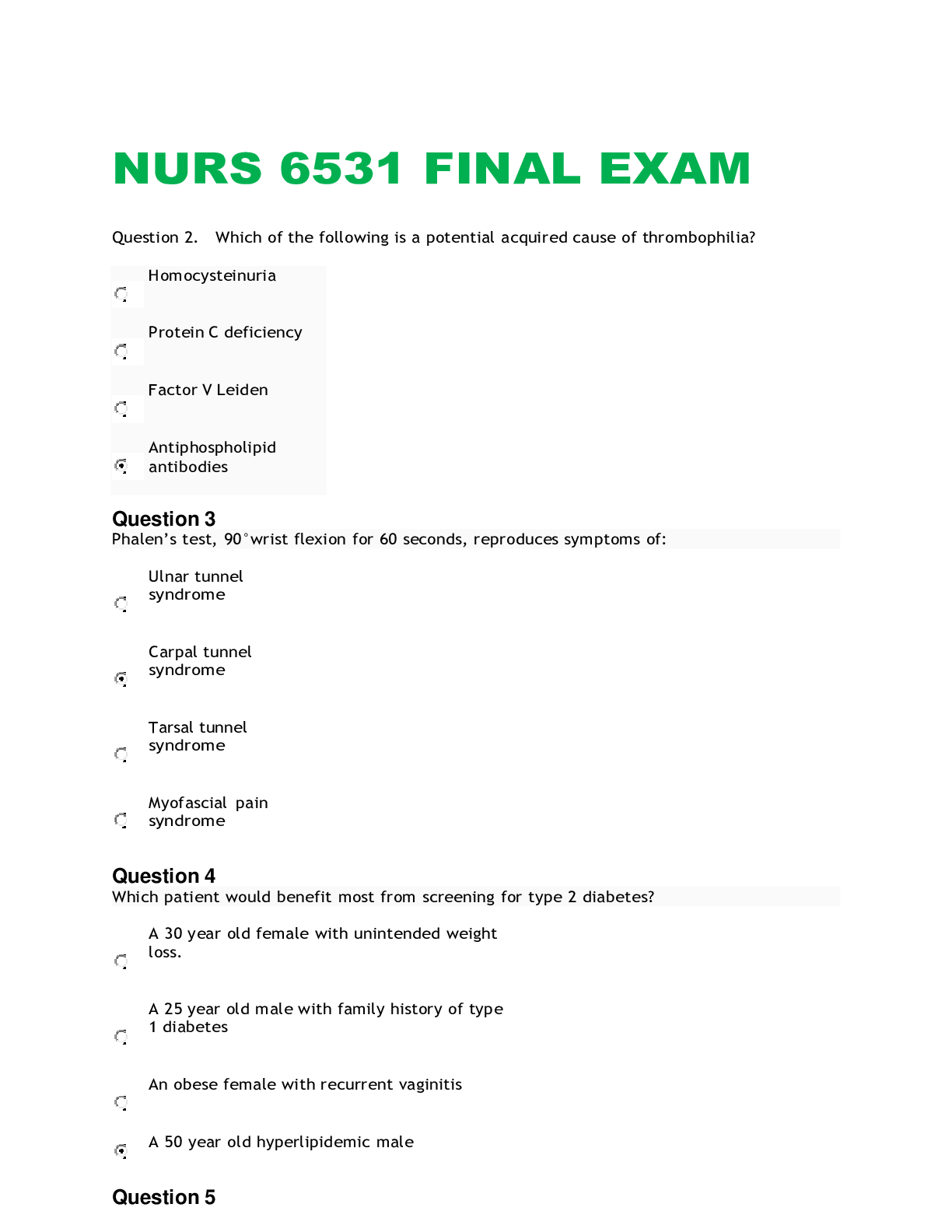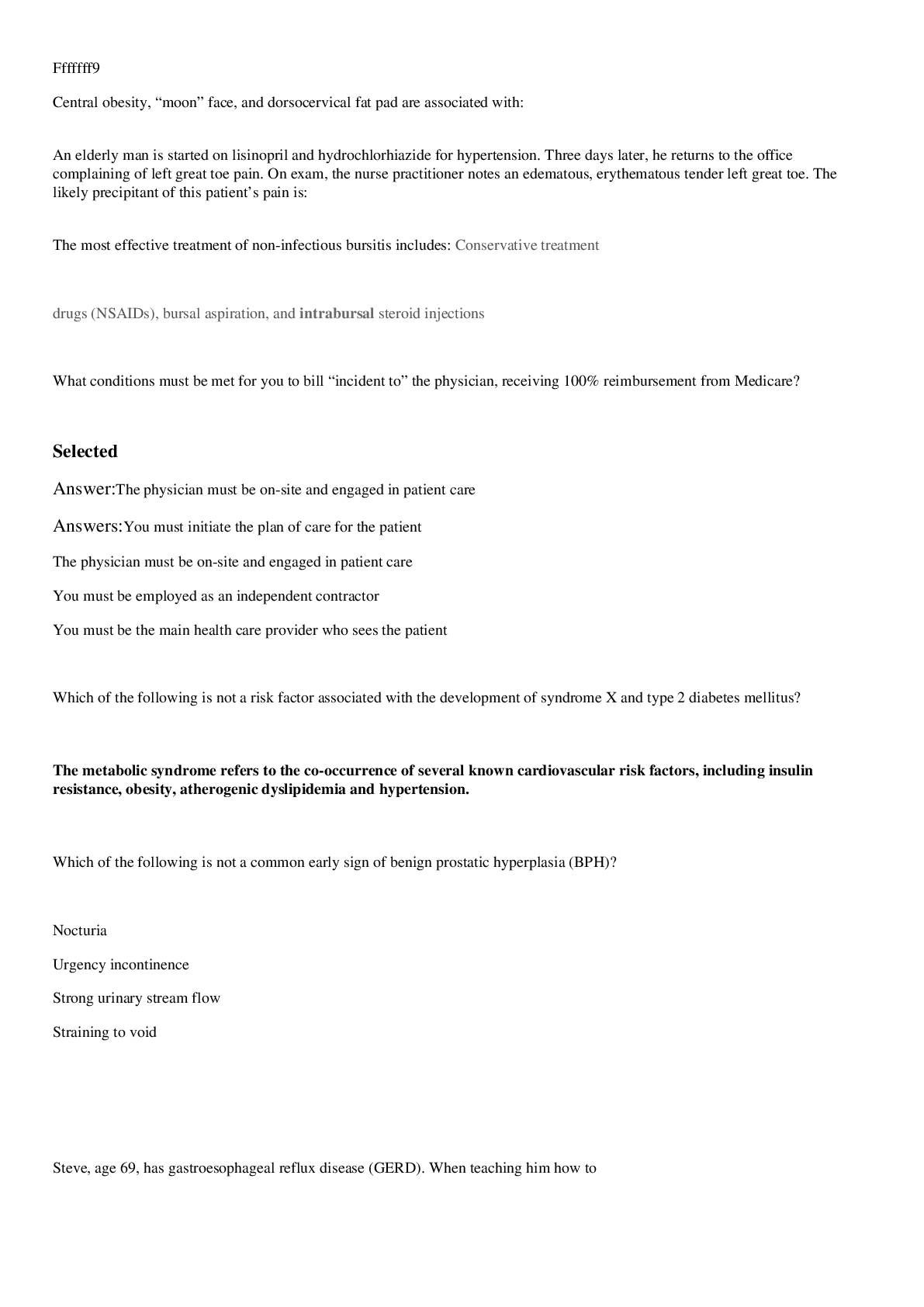*NURSING > Final Exam Review > NSG 2042 Final review outline (All)
NSG 2042 Final review outline
Document Content and Description Below
NSG 2042 Final review NSG 2042- Final Exam Review Outline For all areas and topics be sure to review Nursing Process: • Assessment- Class 1- Health Care Delivery/Concepts in Nursing/ Nursing Pro... cess Quality Care and Safety- National patient safety goals, QSEN competencies (know all 6), SBAR Joint Commission: National Patient Safety Goals QSEN (Quality Safety and Education for Nurses) 6 QSEN competencies SBAR: how you should report something Components of Critical Thinking Clinical Judgement Model (Tanner 2006, 2009)- “ thinking like a nurse” Nursing Process, Learner Readiness, teach back The Nursing Process: Assessment: Diagnosis: Outcomes / Planning: Implementation: Evaluation: **Assesment: A- airway B- breathing C- circulation Teaching and Learning learning: teaching: Teach back Class 2- Asepsis, Safety, Hygiene and skin care Precautions Standard Precautions: Transmission-Based Precautions: Airborne Precautions: Droplet Precautions: • PPE Contact PrecautionsPPE Factors that attribute to falls/fall prevention DAME Acronym to Assess Risk for Falls in Older Adults D- If you don’t see the wound bed in an open pressure ulcer because of yellow, tan, or black slough it must be documented as an “unstageable ulcer” • Nursing Interventions: Pain- Ch. 12 Pain assessment: PAIN IS SUBJECTIVE- it is what the patient says it is • Scales: make sure you use correct scale for developmental age o Characteristics of pain: COLDSPA OLDCARTS Intensity Quality Personal meaning o acute pain: Past experience Gender • Pain management o PCA: Fluid & Electrolytes/ Acid-Base Imbalances- Ch. 13 Homeostatic mechanisms- Kidney, adrenal gland, lungs, parathyroid, pituitary, heart Kidney’s Role: Adrenal Glands: o ) Heart & Blood Vessel’s: Lung’s: Pituitary Gland: Parathyroid Gland: Normal Urine output: 30cc Fluid volume excess and fluid volume deficit- s/s in patient, nursing care and priorities Fluid Volume Deficit (FVD): Hypovolemia Hypovolemia Symptoms: Medical management: Fluid Volume Excess (FVE): Hypervolemia ypervolemia Symptoms: Management: • Medical Management • Nursing Management Lab values and Hyper and Hypo for electrolytes (esp. Potassium, Sodium, Calcium and Magnesium) Electrolytes: Sodium: 135-145 mEq/L - (NEURO SYMPTOMS) sodium is the most abundant electrolyte in ECF • Hyponatremia: serum sodium <135 • Hypernatremia: serum sodium >145 Potassium: 3.5-5.0 mEq/L – (CARDIAC SYMPTOMS) • Hypokalemia: serum potassium <3.5 • Hyperkalemia: serum potassium >5.0 Calcium: 8.6-10.2 mg/dL (NEUROMUSCULAR SYMPTOMS) • Hypocalcemia: serum calcium <8.6 • Hypercalcemia: > 10.2 Magnesium: 1.3-2.3 mg/dL • Hypomagnesemia: <1.3 • Hypermagnesemia: >2.3 Phosphorus: 2.5-4.5 mg/dL • Hypophosphatemia: <2.5 • Hyperphosphatemia: >4.5 Acid/Base Imbalances- REMEMBER RO-ME • Components of arterial blood: ROME: Respiratory Opposite, Metabolic Equal Metabolic Acidosis: Low pH < 7.35 Low HCO3 < 22 Cause: Renal Failure, GI loss- diarrhea Manifestations Treatment: Metabolic Alkalosis: High pH > 7.45 High HCO3 > 26 Causes: Manifestations Treatment: Respiratory Acidosis: Low pH < 7.35 High PaCO2 > 45 Causes: HYPOVENTILATION ( Manifestations: Treatment: Respiratory Alkalosis High pH > 7.45 Low PaCO2 < 35 Causes: HYPERVENTILATION Manifestations: Shock- Ch. 14 Hypovolemic Shock: Caused by: Compensatory Stages of Shock: Treatment: Perioperative Care- Ch. 17, 18, 19 Phases of Perioperative Care: 1. Preoperative Care: o Informed consent: o Teaching: o Assessment: Initial Preop. Assessment o Risk factors/Considerations: o Health history o Instructions to prevent complications post-op: Preventing Atelectasis Preventing DVT: improve circulation and respiratory function Categories of Surgery based on Urgency: Classification Indication for surgery Types of Anesthesia’s: Inhalation, Intravenous, Regional, Local 2. Intraoperative Care: Surgical environment: surgical asepsis o Role of nurse: o Protecting the patient: Intra-op complications: Malignant hyperthermia: rare inherited muscle disorder *CAN BE LIFE THREATENING S/S: Tachycardia*often earliest sign, muscle stiffness, unstable, elevated BP, rapid rising temperature, tachypnea/hypoxia, elevated CK/hyperkalemia/hypercalcemia Management: **discontinue anesthesia**, reverse metabolic &respiratory acidosis, start active cooling to Patient positioning: Laparotomy position, Trendelenburg, Lithotomy position-side lying(Sims) Nursing interventions in Intra-Operative Period: 3. Postoperative Care: begins with the admission of the patient to the PACU & ends with a follow-up evaluation in the clinical setting or home o PACU: Post Anesthesia Care Unit o PACU nurse responsibilities: • PATIENT STATUS EVERY 15 MINS o Transfer criteria: o Post op complications: Intervene at first sign of nausea: turn pt to one side, prevent aspiration, protect airway Respiratory Function and Disorders- Ch. 20-24 • Assessment: o • History: o Breath sounds • Diagnostics: • Atelectasis: Collapse or airless condition of alveoli caused by hypoventilation, obstruction to airways or compression • Pneumonia (assessment, care of patient and prevention) o : • TB: mycobacterium, acid-fast aerobic rod o S/S: low-grade fever, cough, night sweats, fatigue, wt loss o Transmission: airborne, droplet precautions o TB Skin test: Treatment: • Anti-TB agents for 6-12 months o Ensures eradication o Prevents relapse • INH o Preventive for those at-risk • Rifampin • Combination therapy • Monitor liver enzymes, BUN & creatinine monthly Nursing management: • Pleural effusion: o Pleural Conditions • Empyema o • ARDS: Acute Respiratory Distress Syndrome- have to intubate …………………………………………………………………….continued………………………………… [Show More]
Last updated: 2 years ago
Preview 1 out of 79 pages
.png)
Buy this document to get the full access instantly
Instant Download Access after purchase
Buy NowInstant download
We Accept:

Reviews( 0 )
$15.00
Can't find what you want? Try our AI powered Search
Document information
Connected school, study & course
About the document
Uploaded On
Jan 09, 2021
Number of pages
79
Written in
Additional information
This document has been written for:
Uploaded
Jan 09, 2021
Downloads
0
Views
80













